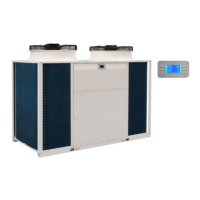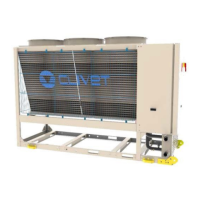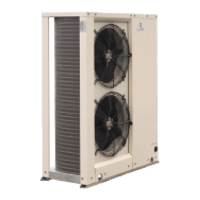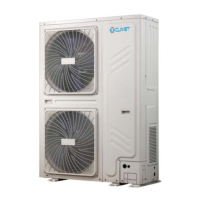Do you have a question about the CLIVET MSAT-XEE 18.2 and is the answer not in the manual?
Instructs on immediate unit deactivation and contacting certified service agents.
Details procedures for safe and proper handling and lifting of the unit.
Lists criteria for selecting an installation location, considering various factors for optimal performance.
Warns about potential explosion risks from trapped refrigerant due to temperature increases.
Provides steps for pressurizing the system with nitrogen and checking for refrigerant leaks.
Outlines the process for creating a vacuum in the refrigerant circuit.
Details the procedure for charging the system with the correct refrigerant.
Lists essential steps for making electrical connections, emphasizing safety and verification.
Illustrates the customer's connection points for electrical power and remote control.
Lists essential checks to perform before powering up the unit.
Details the step-by-step sequence for starting the unit's power supply.
Covers checks for correct compressor rotation and refrigerant circuit parameters.
Details checks for grounding, conductor tightness, voltage, and phase balance.
Explains the importance and procedure for activating compressor crankcase heaters.
Explains the ON/OFF function, including emergency stop procedures.
Lists alarm codes, their descriptions, and types (AUTO/Manual).
Details the procedure for resetting alarms after the cause has been addressed.
Introduces the setting menu for configuring various unit parameters.
Explains how to manage and set up daily operating schedules.
Recommends inspection intervals, suggesting shorter periods for frequent or critical use.
Presents a detailed checklist of control system components and their inspection frequency.
Explains how to clean the air coil fins safely to maintain thermal exchange.
Warns about risks associated with improper handling and the need for protection.
Highlights risks from incorrect installation, leaks, and inadequate support.
Details risks associated with electrical connections, grounding, and internal components.
Warns about injuries from contact with moving parts like transmissions or fans.
Addresses risks from refrigerant expulsion, explosion, and heating.
Illustrates the unit's operating temperature ranges for different configurations.
Lists alarm codes, their descriptions, and types (AUTO/Manual).
Instructs on immediate unit deactivation and contacting certified service agents.
Details procedures for safe and proper handling and lifting of the unit.
Lists criteria for selecting an installation location, considering various factors for optimal performance.
Warns about potential explosion risks from trapped refrigerant due to temperature increases.
Provides steps for pressurizing the system with nitrogen and checking for refrigerant leaks.
Outlines the process for creating a vacuum in the refrigerant circuit.
Details the procedure for charging the system with the correct refrigerant.
Lists essential steps for making electrical connections, emphasizing safety and verification.
Illustrates the customer's connection points for electrical power and remote control.
Lists essential checks to perform before powering up the unit.
Details the step-by-step sequence for starting the unit's power supply.
Covers checks for correct compressor rotation and refrigerant circuit parameters.
Details checks for grounding, conductor tightness, voltage, and phase balance.
Explains the importance and procedure for activating compressor crankcase heaters.
Explains the ON/OFF function, including emergency stop procedures.
Lists alarm codes, their descriptions, and types (AUTO/Manual).
Details the procedure for resetting alarms after the cause has been addressed.
Introduces the setting menu for configuring various unit parameters.
Explains how to manage and set up daily operating schedules.
Recommends inspection intervals, suggesting shorter periods for frequent or critical use.
Presents a detailed checklist of control system components and their inspection frequency.
Explains how to clean the air coil fins safely to maintain thermal exchange.
Warns about risks associated with improper handling and the need for protection.
Highlights risks from incorrect installation, leaks, and inadequate support.
Details risks associated with electrical connections, grounding, and internal components.
Warns about injuries from contact with moving parts like transmissions or fans.
Addresses risks from refrigerant expulsion, explosion, and heating.
Illustrates the unit's operating temperature ranges for different configurations.
Lists alarm codes, their descriptions, and types (AUTO/Manual).











